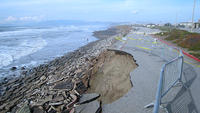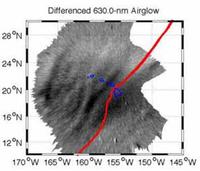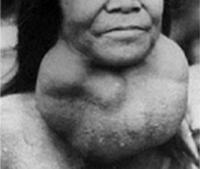-
Sensor network to provide early quake alerts
Researchers from U.S. universities are collaborating to implement a new network of seismic sensors aimed at arming communities with early earthquake detection and warning capabilities; the sensors, no bigger than a Post-it note, are part of a new phase of the Quake-Catcher Network (QCN), a project gathering detailed data to help scientists understand the earthquake process and how to mitigate against its effects
-
-
U.S. West Coast is rapidly eroding, with pace to accelerate

The stormy conditions of the 2009-10 El Nino winter eroded beaches from San Diego to Seattle to often unprecedented levels; the higher sea levels expected due to global warming, and potentially even stronger winter storms, will likely to contribute to increased rates of beach and bluff erosion along much of the U.S. West Coast
-
-
Method for early detection of tsunami found

Researchers, for the first time, have recorded an airglow signature in the upper atmosphere produced by a tsunami; the signature, caused by the 11 March earthquake that devastated Japan, was observed in an airglow layer 250 kilometers above the Earth’s surface; it preceded the tsunami by one hour, suggesting that the technology could be used as an early-warning system in the future
-
-
Preparing for the worst
Nearly three quarters (73 percent) of companies surveyed by AT&T are calling business continuity a priority in 2011, and almost half of them are seriously thinking about using cloud technology to help them deal with terrorism threats, security breaches, the problems that come when the power goes out or the weather turns extreme
-
-
Japan's prime minister pushes to end nuke program
Japan could soon be following in the footsteps of Germany and shut down its nuclear energy plants; at a televised press conference on Wednesday, Prime Minister Naota Kan pushed to end Japan’s nuclear program; “Japan should aim for a society that does not depend on nuclear energy,” Kan said
-
-
Understanding deadly tornadoes

Scientists at the University of Alabama in Huntsville (UAH) are analyzing radar data from 27 April 2011 — the day that saw of the deadliest tornado outbreaks in U.S. history — then merging the information with detailed storm surveys and other data; they hope to learn more about how the storms formed, what made the storms so powerful and what might be done to make tornado warnings more effective
-
-
Volunteers help California build quake sensor network
Thousands of residents across California are helping the U.S Geological Survey (USGS) build a dense network of seismic sensors across the state; as part of the Quake Catcher Network, Californians are being asked to place 6,000 seismic sensors in their homes to help geologists study earthquakes
-
-
Louisiana parish plans extreme weather alert system
Emergency officials in Ouachita Parish, Louisiana are considering installing warning sirens that would alert residents of dangerous weather; officials hope to install sixty towers throughout the Parish; authorities are currently conducting feasibility studies to determine if installing the sirens is practical and a financial possibility
-
-
Trapped couple receives bill for stay in New Zealand hotel during quake
A couple stuck in a Christchurch, New Zealand hotel after the 22 February 6.3 magnitude earthquake struck the city, was shocked to discover they had been charged for their stay; a New Zealand man and his wife were trapped on the hotel’s twenty-second floor for hours and eventually were forced to escape after daringly crossing collapsed stair cases, smashing down doors, and crawling to the roof of a parking lot nearby
-
-
45 percent of children in Fukushima exposed to thyroid radiation

A survey revealed that 45 percent of children living near the Fukushima Daiichi nuclear power plant have been exposed to thyroid radiation; following the nuclear disaster and the revelation that radiation was leaking from reactor no. 1, researchers tested more than 1,000 children from newborns to age fifteen in the Fukushima Prefecture; children were found to have been exposed to 0.04 microsievert per hour or less in most cases
-
-
Key to coping with disasters: neighbors
A political scientist who had moved to New Orleans only weeks before Hurricane Katrina concluded that neighbors — and cooperation among neighbors — are more important for surviving, coping with, and recovering from disasters than ambulances and fire trucks and government aid; to make sure his observations were more than anecdotal, he visited disaster areas around the world, and his data show that his personal experiences reflect a larger truth
-
-
Disasters hit businesses hard, keeping many permanently closed
Business owners across the United States are being urged to create emergency plans, so that they can continue operating in the wake of a natural disaster; according to the Insurance Institute for Business and Home Safety, 25 percent of businesses hit by a natural disaster are unable to continue functioning
-
-
Missouri struggles to pay for natural disasters
Last week, Missouri governor Jay Nixon ordered his state budget director to put aside an additional $100 million to help the state’s disaster stricken areas recover; Governor Nixon has already ordered $50 million to be withheld, but Linda Luebbering, the state budget director, worries that the $150 million is not enough
-
-
Quake-resistant superelastic alloy developed
Japanese scientists added a small amount of nickel to an iron-based alloy, and found that the new material can recover its original shape at any temperature from -196 to 240 degrees Celsius; the material may be used in environments that are constantly exposed to extreme temperatures, such as joints and controls in cars, planes, and spacecraft; it may also help buildings cushion stress and violent movement in earthquakes
-
-
Los Alamos nuclear waste safe from wildfire
A wildfire is raging near the Los Alamos national Lab; the fire, in some places, is only yards away from the lab’s outside perimeter — and it is eight miles from the so-called Area G; the Area G site is a 63-acre storage facility where thousands of drums of nuclear waste sit, many of which are outdoors started; the good news is that there is no danger that the fire will reach Area G because in 2000, an even more intense fire burned 90 percent of the forest that covered the area between the current fire and the nuclear waste disposal site, making it impossible for the current wild fire to reach the nuclear material on storage
-
More headlines
The long view
Using Drone Swarms to Fight Forest Fires
Forest fires are becoming increasingly catastrophic across the world, accelerated by climate change. Researchers are using multiple swarms of drones to tackle natural disasters like forest fires.
How Climate Change Will Affect Conflict and U.S. Military Operations
“People talk about climate change as a threat multiplier,” said Karen Sudkamp, an associate director of the Infrastructure, Immigration, and Security Operations Program within the RAND Homeland Security Research Division. “But at what point do we need to start talking about the threat multiplier actually becoming a significant threat all its own?”
